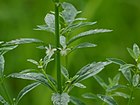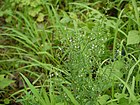Note: This is a project under development. The articles on this wiki are just being initiated and broadly incomplete. You can Help creating new pages.
Difference between revisions of "Scoparia dulcis - Sweet Broom Weed"
(→Commonly seen growing in areas) |
|||
| (13 intermediate revisions by 2 users not shown) | |||
| Line 3: | Line 3: | ||
==Uses== | ==Uses== | ||
| − | {{Uses|Gastralgia}}, {{Uses|Dysentery}}, {{Uses|Intestinal affections}}, {{Uses|Fever}}, {{Uses|Enteritis}}, {{Uses|Beriberi}}, {{Uses| | + | {{Uses|Gastralgia}}, {{Uses|Dysentery}}, {{Uses|Intestinal affections}}, {{Uses|Fever}}, {{Uses|Enteritis}}, {{Uses|Beriberi}}, {{Uses|Swelling}}, {{Uses|Diarrhea}}, {{Uses|Cough}}, {{Uses|Kidney complaints}}, {{Uses|Indigestion}}, {{Uses|Colic}}<ref name="Uses"/> |
==Parts Used== | ==Parts Used== | ||
| − | {{Parts Used| | + | {{Parts Used|Leaf}}<ref name="Karnataka Medicinal Plants"/> |
==Chemical Composition== | ==Chemical Composition== | ||
| − | Palmitic acid, | + | Palmitic acid, B-sitosterol, Glutinol, and a mixture of B-amyrin and Isomultiflorenol<ref name="chemical composition"/> |
==Common names== | ==Common names== | ||
| − | {{Common names|kn=|ml=|sa=|ta=Sarakkotthini|te=|hi=Mithi patti|en=Sweet Broom Weed, Sweet Broom Wort}} | + | {{Common names|kn=Manitumbe gida|ml=|sa=|ta=Sarakkotthini|te=POttiboli|hi=Mithi patti, Jaldaniya|en=Sweet Broom Weed, Sweet Broom Wort}}<ref name="Karnataka Medicinal Plants"/> |
==Properties== | ==Properties== | ||
| Line 38: | Line 38: | ||
===Flower=== | ===Flower=== | ||
| − | {{Flower|Unisexual|2-4cm long|white|5|Flowers are Solitary or 2, axillary and Flowering throughout the year}} | + | {{Flower|Unisexual|2-4cm long|white|5|Flowers are Solitary or 2, axillary and Flowering throughout the year. Flowering from May to October}} |
===Fruit=== | ===Fruit=== | ||
| − | {{Fruit|ellipsoid|7–10 mm|Fruit are globose capsule and Fruiting throughout the year| | + | {{Fruit|ellipsoid|7–10 mm|Fruit are globose capsule and Fruiting throughout the year||Septicidal, Reticulate|Fruiting from May to October}} |
===Other features=== | ===Other features=== | ||
==List of Ayurvedic medicine in which the herb is used== | ==List of Ayurvedic medicine in which the herb is used== | ||
| − | |||
==Where to get the saplings== | ==Where to get the saplings== | ||
| Line 79: | Line 78: | ||
<references> | <references> | ||
| − | <ref name="chemical composition">[http://www.vjs.ac.vn/index.php/vjchem/article/view/4660 | + | <ref name="chemical composition">[http://www.vjs.ac.vn/index.php/vjchem/article/view/4660 Chemical constituents]</ref> |
| − | <ref name="Leaf">[https://indiabiodiversity.org/species/show/231128 " | + | <ref name="Leaf">[https://indiabiodiversity.org/species/show/231128 Morphology]</ref> |
| + | |||
| + | <ref name="How to plant/cultivate">[https://www.pfaf.org/user/Plant.aspx?LatinName=Scoparia+dulcis Cultivation details]</ref> | ||
| + | |||
| + | <ref name="Uses">Karnataka Medicinal Plants Volume - 2 by Dr.M. R. Gurudeva, Page No.585</ref> | ||
| + | |||
| + | <ref name="Karnataka Medicinal Plants">"Karnataka Medicinal Plants Volume - 2" by Dr.M. R. Gurudeva, Page No.584, Published by Divyachandra Prakashana, #45, Paapannana Tota, 1st Main road, Basaveshwara Nagara, Bengaluru. </ref> | ||
| − | |||
</references> | </references> | ||
| Line 94: | Line 98: | ||
[[Category:Herbs]] | [[Category:Herbs]] | ||
| + | [[Category:Plantaginaceae]] | ||
Latest revision as of 16:27, 23 June 2023
Scoparia dulcis is a species of flowering plant in the plantain family and It is native to the Neotropics but it can be found throughout the tropical and subtropical world.
Contents
- 1 Uses
- 2 Parts Used
- 3 Chemical Composition
- 4 Common names
- 5 Properties
- 6 Habit
- 7 Identification
- 8 List of Ayurvedic medicine in which the herb is used
- 9 Where to get the saplings
- 10 Mode of Propagation
- 11 How to plant/cultivate
- 12 Commonly seen growing in areas
- 13 Photo Gallery
- 14 References
- 15 External Links
Uses
Gastralgia, Dysentery, Intestinal affections, Fever, Enteritis, Beriberi, Swelling, Diarrhea, Cough, Kidney complaints, Indigestion, Colic[1]
Parts Used
Chemical Composition
Palmitic acid, B-sitosterol, Glutinol, and a mixture of B-amyrin and Isomultiflorenol[3]
Common names
| Language | Common name |
|---|---|
| Kannada | Manitumbe gida |
| Hindi | Mithi patti, Jaldaniya |
| Malayalam | |
| Tamil | Sarakkotthini |
| Telugu | POttiboli |
| Marathi | NA |
| Gujarathi | NA |
| Punjabi | NA |
| Kashmiri | NA |
| Sanskrit | |
| English | Sweet Broom Weed, Sweet Broom Wort |
Properties
Reference: Dravya - Substance, Rasa - Taste, Guna - Qualities, Veerya - Potency, Vipaka - Post-digesion effect, Karma - Pharmacological activity, Prabhava - Therepeutics.
Dravya
Rasa
Tikta (Bitter), Kashaya (Astringent)
Guna
Laghu (Light), Ruksha (Dry), Tikshna (Sharp)
Veerya
Ushna (Hot)
Vipaka
Katu (Pungent)
Karma
Kapha, Vata
Prabhava
Habit
Identification
Leaf
| Kind | Shape | Feature |
|---|---|---|
| Simple | Oblong-elliptic | Leaf Arrangement is Decussate or whorled |
Flower
| Type | Size | Color and composition | Stamen | More information |
|---|---|---|---|---|
| Unisexual | 2-4cm long | white | 5 | Flowers are Solitary or 2, axillary and Flowering throughout the year. Flowering from May to October |
Fruit
| Type | Size | Mass | Appearance | Seeds | More information |
|---|---|---|---|---|---|
| ellipsoid | 7–10 mm | Fruit are globose capsule and Fruiting throughout the year | Septicidal, Reticulate | Fruiting from May to October |
Other features
List of Ayurvedic medicine in which the herb is used
Where to get the saplings
Mode of Propagation
How to plant/cultivate
A common weed of lowland tropical and subtropical areas, found in areas where it rains all year round and also where there is a prolonged dry season[310 ]. Succeeds in most soils[5]
Commonly seen growing in areas
Subtropical area, Tropical area.
Photo Gallery
References
- ↑ Karnataka Medicinal Plants Volume - 2 by Dr.M. R. Gurudeva, Page No.585
- ↑ 2.0 2.1 "Karnataka Medicinal Plants Volume - 2" by Dr.M. R. Gurudeva, Page No.584, Published by Divyachandra Prakashana, #45, Paapannana Tota, 1st Main road, Basaveshwara Nagara, Bengaluru.
- ↑ Chemical constituents
- ↑ Morphology
- ↑ Cultivation details
External Links
- Ayurvedic Herbs known to be helpful to treat Gastralgia
- Ayurvedic Herbs known to be helpful to treat Dysentery
- Ayurvedic Herbs known to be helpful to treat Intestinal affections
- Ayurvedic Herbs known to be helpful to treat Fever
- Ayurvedic Herbs known to be helpful to treat Enteritis
- Ayurvedic Herbs known to be helpful to treat Beriberi
- Ayurvedic Herbs known to be helpful to treat Swelling
- Ayurvedic Herbs known to be helpful to treat Diarrhea
- Ayurvedic Herbs known to be helpful to treat Cough
- Ayurvedic Herbs known to be helpful to treat Kidney complaints
- Ayurvedic Herbs known to be helpful to treat Indigestion
- Ayurvedic Herbs known to be helpful to treat Colic
- Herbs with Leaf used in medicine
- Herbs with common name in Kannada
- Herbs with common name in Hindi
- Herbs with common name in Tamil
- Herbs with common name in Telugu
- Herbs with common name in English
- Habit - Annual plant
- Index of Plants which can be propagated by Seeds
- Herbs that are commonly seen in the region of Subtropical area
- Herbs that are commonly seen in the region of Tropical area
- Herbs
- Plantaginaceae





